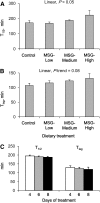Supplementing monosodium glutamate to partial enteral nutrition slows gastric emptying in preterm pigs(1-3)
- PMID: 23446960
- PMCID: PMC3970318
- DOI: 10.3945/jn.112.167783
Supplementing monosodium glutamate to partial enteral nutrition slows gastric emptying in preterm pigs(1-3)
Abstract
Emerging evidence suggests that free glutamate may play a functional role in modulating gastroduodenal motor function. We hypothesized that supplementing monosodium glutamate (MSG) to partial enteral nutrition stimulates gastric emptying in preterm pigs. Ten-day-old preterm, parenterally fed pigs received partial enteral nutrition (25%) as milk-based formula supplemented with MSG at 0, 1.7, 3.0, and 4.3 times the basal protein-bound glutamate intake (468 mg·kg(-1)·d(-1)) from d 4 to 8 of life (n = 5-8). Whole-body respiratory calorimetry and (13)C-octanoic acid breath tests were performed on d 4, 6, and 8. Body weight gain, stomach and intestinal weights, and arterial plasma glutamate and glutamine concentrations were not different among the MSG groups. Arterial plasma glutamate concentrations were significantly higher at birth than after 8 d of partial enteral nutrition. Also at d 8, the significant portal-arterial concentration difference in plasma glutamate was substantial (∼500 μmol/L) among all treatment groups, suggesting that there was substantial net intestinal glutamate absorption in preterm pigs. MSG supplementation dose-dependently increased gastric emptying time and decreased breath (13)CO2 enrichments, (13)CO2 production, percentage of (13)CO2 recovery/h, and cumulative percentage recovery of (13)C-octanoic acid. Circulating glucagon-like peptide-2 (GLP-2) concentration was significantly increased by MSG but was not associated with an increase in intestinal mucosal growth. In contrast to our hypothesis, our results suggest that adding MSG to partial enteral nutrition slows the gastric emptying rate, which may be associated with an inhibitory effect of increased circulating GLP-2.
Conflict of interest statement
Author disclosures: C. Bauchart-Thevret, B. Stoll, N. M. Benight, O. Olutoye, D. Lazar, and D. G. Burrin, no conflicts of interest.
Figures




References
-
- Reeds PJ, Burrin DG, Stoll B, Jahoor F. Intestinal glutamate metabolism. J Nutr. 2000;130(Suppl):978S–82S - PubMed
-
- Cartmell J, Schoepp DD. Regulation of neurotransmitter release by metabotropic glutamate receptors. J Neurochem. 2000;75:889–907 - PubMed
-
- Chandrashekar J, Hoon MA, Ryba NJ, Zuker CS. The receptors and cells for mammalian taste. Nature. 2006;444:288–94 - PubMed
-
- Beauchamp GK. Sensory and receptor responses to umami: an overview of pioneering work. Am J Clin Nutr. 2009;90(Suppl):723S–7S - PubMed
Publication types
MeSH terms
Substances
Grants and funding
LinkOut - more resources
Full Text Sources
Other Literature Sources
Medical

